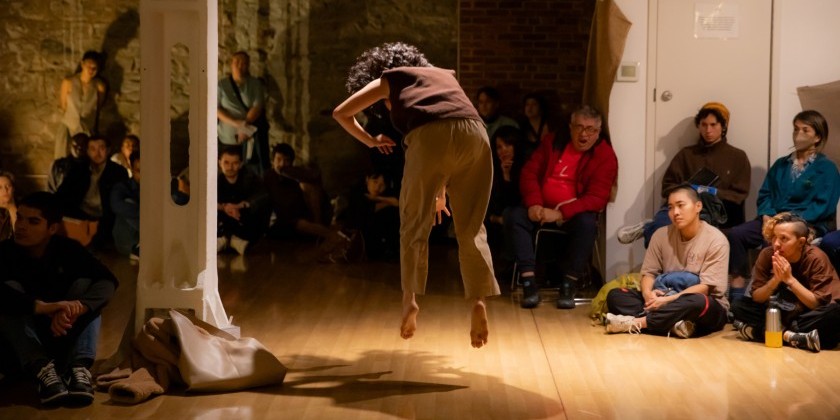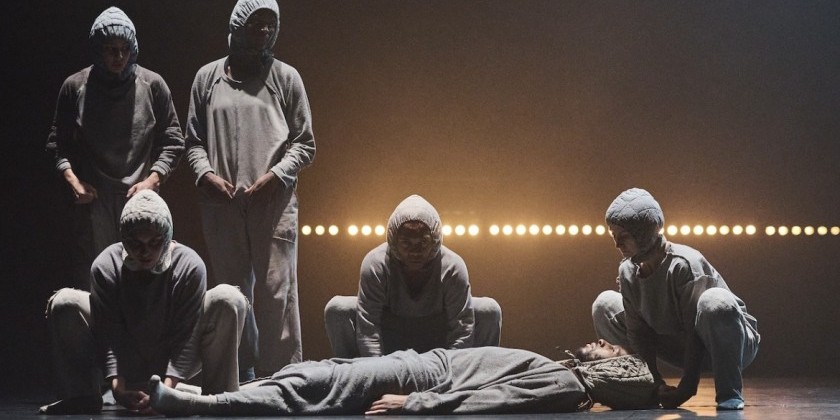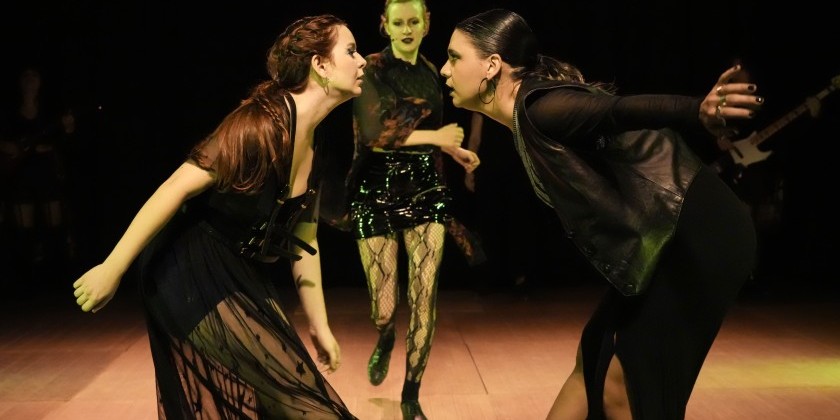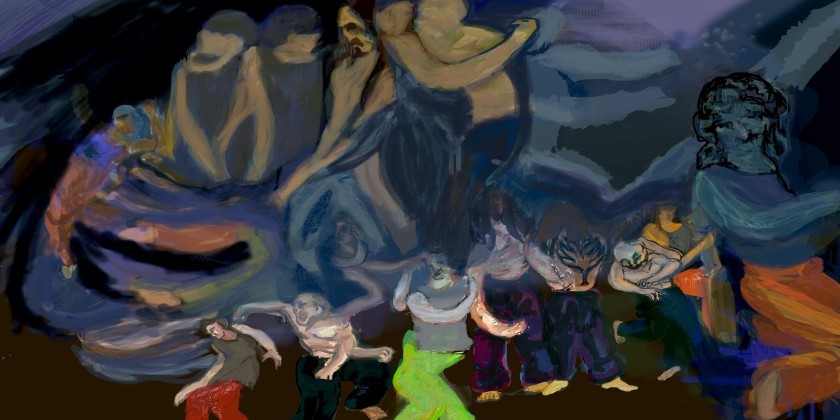AUDIENCE REVIEW: INTERPLAY - General Mischief Dance Theatre

Company:
General Mischief Dance Theatre
Performance Date:
September 28, 2019
Freeform Review:
General Mischief Dance Theatre presents Interplay
In collaboration with 41street Ensemble
Choreography by
Emily Smyth Vartanian (Head Troublemaker)
Karen Gayle (Guest Choreographer)
Featuring performances by
Jane Abbott, Brianna Anderson, Maiko Harada, Ellen Henry, Anthony Jenkins, Wendy Lechuga, Saki Masuda, Allyson Ross, Richard Sayama, Kierstyn Sharrow, Peter Trojić, Emily Smyth Vartanian, and JP Viernes
***
The artists of General Mischief Dance Theatre know how to warp eighty minutes into a whimsical evening at the theater – that everyone gets to be a part of!
General Mischief Dance Theatre’s INTERPLAY premiered at The City College of New York’s Aaron Davis Hall on September 27-28, 2019. INTERPLAY was an evening of dance performance in collaboration with live music by The 41street Ensemble of Oakland, CA. It was such a treat that the dancing was accompanied by such beautiful, live music! So much magic (and mischief) can happen during live performance.
INTERPLAY featured four dances:
The Shell Game (Emily Smyth Vartanian)
Walk Softly (Emily Smyth Vartanian)
The Waiting Room (Karen Gayle)
Back/Story (premiere) [Emily Smyth Vartanian]
The performance also featured a piece of music titled Borboleta – composed by Erika Luckett – which was second to last on the program.
General Mischief Dance Theatre values audience involvement; this was introduced from the start of the show, when The Shell Game invited audience members to play. The Shell Game’s task was to keep track of which dancer (of eight) wore a top hat with a red interior. Every dancer was dressed identically in all black; they wore long-sleeved mesh leotards, black pants, black character shoes, and black top hats. One of the top hats contained a red interior, which the company showed the audience before dancing. The Shell Game began as a trio, but the remaining five dancers trickled in – becoming increasingly tricky to keep track of the red hat. The Shell Game celebrated its tenth year in General Mischief Dance Theatre’s repertory this year, so I was glad to play this game. However, I lost track of the red hat because I was enjoying the sultry, jazzy choreography! Set to The Pink Panther theme music, the company’s large dance movements and nostalgic music choice shamelessly distracted me. Other audience members found the red hat right away. The Shell Game was a short, sweet and sparkly opening to INTERPLAY.
Walk Softly, second on the program, was a dance for nine. Considerably more serious in subject matter than The Shell Game, this piece offered themes of community, cooperation, and peace. The dancers were dressed in shades of blue, white, and black. Walk Softly began with seven dancers seated, spread out evenly through the stage, in an almost meditative practice. Some appeared to be self-reflecting, while others conversed with each other. Walk Softly later proved to be very movement-oriented and rhythmic, while bringing props to life. The dancers carried what looked like wooden staffs – and there were dozens of those staffs! The dancers passed them amongst one another, hit them into the floor, and whirled them around harmoniously with the music – which was recorded by collaborators The 41street Ensemble and The VNote Ensemble. After the performance, I learned that Walk Softly was inspired by Quitiplas, which are bamboo stamping tubes used as instruments. This explained why the dancers’ musicality was so strong. However, I remember seeing Ellen Henry holding all of the bamboo tubes by herself, and it made me question why her community insisted she carry all of the “burden.” It was relieving when the other dancers removed the weight of the staffs from her arms. A memorable moment near the end of the dance was when the nine dancers stood in an enormous circle, and traded the Quitiplas – this demonstrated community action. Even if one of the staffs fell, the dancers were there for each other.
Guest choreographer Karen Gayle’s The Waiting Room offered an even darker, more intense atmosphere. I applaud Karen Gayle for masterfully pulling the theatrical elements of General Mischief Dance Theatre into this dance, for the performers were extremely committed and believable. When the lights came up, the dancers were visible in shades of red, gray and black. Six chairs were arranged in a line on stage, with a gap in the line at center stage. Five dancers were seated out of the six chairs. Three more dancers stood ominously in a second line, behind the chairs. The scene was tense; the dancers stared (perhaps glared is more appropriate) straight out into the audience, as the music (which sounded like a timer ticking down layered with melody) fostered a nervous mood. Suddenly, all of the dancers moved their heads very quickly to their left, and then back again. This repeated. The stillness the dancers held was powerful. Every dancers’ face was wrought with apprehension, and soon their bodies pulsed with nervous tics. Their quivering was in accordance with the music, The Roof by Tom Tykwer. The piece was extremely musical, overall. The dancers broke off into their own solo gestural material, mostly using their upper bodies, and later the seated dancers rose from their chairs and employed larger movements. Gayle’s choreography had beautiful suspension, and it dripped with drama. Even after dancing phrases together in unison, the dancers would return to their original seats and employ the same stillness as in the beginning.
Back/Story premiered last on the program, with the 41street Ensemble’s live accompaniment. Back/Story offered six scenes (and one coda) arranged in reverse order of the story’s events. The plot centers around employees working in an office, and their lives as a community outside of work. Because of this community-oriented story, the audience is able to take away many different scenarios that explore human relationships. For example, the second vignette, set in a yoga class, explored one woman’s transformation from frustrated, flustered student into someone who is able to accept each person’s individuality, as well as accept what she is capable of. The third vignette, a trio, offered a love triangle, which unfortunately resulted in the loss of a friendship. We also see themes of women supporting women, long-distance relationships, miscommunication over text messaging – the mass amount of human exchanges in this piece made it all the more relatable. Movement wise, the dancers performed wholeheartedly. Whether they were executing a grande jete through an office scene, dancing in a cocktail party, diving into a handstand during yoga, or twirling around the stage with a dance partner, their energy extended through the edges of their limbs. This allowed the space to seem fuller, and supplemented the human element that Back/Story offered.
To complete a full-circle participation theme of Interplay, the audience was again encouraged to be a part of the fun! In a final, explosive moment in Back/Story, audience members tossed their own paper airplanes in the final vignette. It was a scene where virtually everyone in the company’s characters quit their office jobs - and we joined in their celebration.
I offer my sincerest congratulations to the artists of General Mischief Dance Theatre, and the 41street Ensemble. They encouraged their audiences to “be present for the moment of mischief,” which I felt constantly throughout their performance of INTERPLAY.
Author:
Kristen Hedberg
Website:
kristenhedberg.org
Photo Credit:
Lynn Redmile











